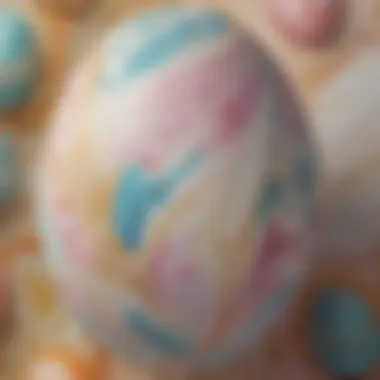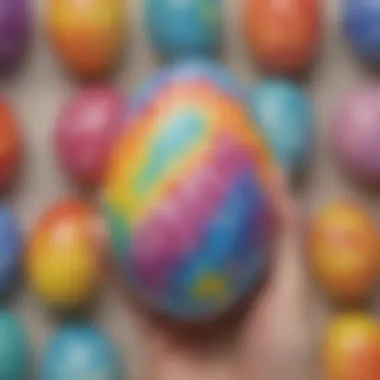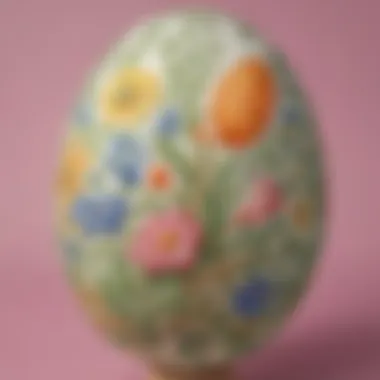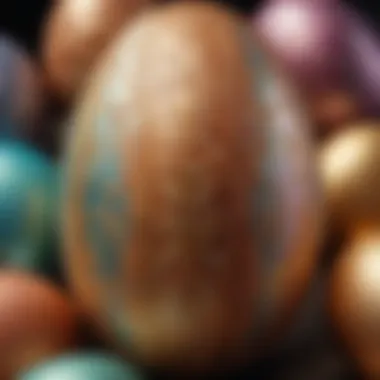Discover Innovative Ways to Color Easter Eggs and Elevate Your Decorating Game


Fun Activities Ideas
Easter is a time full of joy and creativity, making it the perfect occasion for fun activities like coloring Easter eggs. Whether you prefer indoor activities that involve intricate designs or outdoor adventures while you gather natural dyes, there are endless possibilities to explore. Engaging in arts and crafts can enhance fine motor skills and bring out your artistic side, while love for science can lead you to experiment with various egg-dyeing techniques. Cooking and baking can also be integrated into the egg-coloring process, adding a flavorful twist to your creations.
Introduction
In the spectrum of Easter traditions, coloring eggs stands as a cherished practice that encompasses creativity and festivity. The art of decorating eggs during Easter has a history that dates back centuries, symbolizing new life and rebirth. This article embarks on a journey through various innovative techniques that elevate egg coloring beyond the conventional, aiming to inspire individuals seeking to add a dash of uniqueness to their Easter celebrations. From traditional methods rich in cultural significance to contemporary twists that push the boundaries of creativity, readers will discover a plethora of intriguing ideas to infuse vibrancy and charm into this traditional Easter activity.
Brief Overview of Easter Egg Coloring
Historical Significance
The Historical Significance of egg coloring traces back to ancient civilizations like the Egyptians and Persians, where eggs were seen as symbols of fertility and renewal. This tradition later evolved in Christian cultures, particularly during Lent, symbolizing the Resurrection of Jesus. The use of natural dyes extracted from plants and fruits was a common practice, infusing eggs with earthy tones and simple elegance, reflective of a simpler time yet resonating with a timeless appeal.
Cultural Traditions
Cultural Traditions surrounding Easter egg coloring vary across regions, each adding a unique touch to this timeless practice. In Greece, red eggs are commonly exchanged during Easter, symbolizing the blood of Christ. Similarly, Slavic cultures adorn eggs with intricate patterns using wax-resist methods, reflecting a blend of religious symbolism and artistic expression. These cultural nuances enrich the tradition of egg coloring, showcasing the diversity and beauty of global celebrations.
Importance of Easter Eggs in Celebrations
Symbolism of Rebirth
The Symbolism of Rebirth embodied in Easter eggs transcends mere decoration, carrying profound meanings of renewal and transformation. The egg, a universal symbol of fertility and life, symbolizes the emergence of new beginnings and opportunities. By dyeing eggs in vibrant colors symbolizing growth and vitality, individuals partake in a symbolic act of embracing the changing seasons and the promise of fresh starts.
Festive Symbol
Easter eggs serve as a Festive Symbol of joy and abundance, heralding the arrival of spring and the renewal of life. Decorating eggs in lavish colors and patterns not only adds visual delight to Easter festivities but also creates a sense of anticipation and excitement, especially for children. The act of embellishing eggs with care and creativity reinforces the spirit of togetherness and celebration during this cherished holiday season, making it a memorable tradition for families and communities to cherish.
Traditional Egg Coloring Techniques
Traditional Egg Coloring Techniques play a pivotal role in this extensive guide on exploring various methods for coloring Easter eggs. By delving into traditional techniques, individuals can gain a deeper appreciation for the roots of egg decoration and infuse a sense of heritage into their creations. Understanding the traditional practices also provides a solid foundation for exploring more innovative and modern approaches to egg coloring. The benefits of traditional egg coloring techniques lie in their time-tested effectiveness and the ability to create classic, timeless designs that hold cultural significance. Additionally, these techniques offer a sense of nostalgia and charm that resonates with individuals looking to connect with age-old Easter traditions.
Classic Dyeing
Use of Food Coloring


The use of food coloring in egg dyeing is a classic and widely embraced method known for its vibrant and consistent color results. Food coloring presents a convenient and accessible option for individuals seeking to achieve bold hues on their Easter eggs. One of the key characteristics of using food coloring is its versatility, allowing for a diverse range of colors to be easily created by mixing different shades. This method is particularly beneficial for this article as it caters to a broad audience with varying color preferences. However, a potential downside of using food coloring is that some artificial dyes may not be food-safe, requiring careful selection of products to ensure edible decorations.
Vinegar Bath Method
The vinegar bath method is a crucial step in classic egg dyeing, where eggs are soaked in a mixture of vinegar and food coloring to achieve vibrant and long-lasting colors. The key characteristic of this method is its ability to enhance the color absorption of the dye, resulting in more intense and uniform shades on the eggs. The use of vinegar in the dye solution helps the color adhere better to the eggshell, ensuring a striking visual impact. This method's advantage lies in its effectiveness in producing richly colored eggs suitable for both traditional and modern Easter displays. However, a potential drawback is the strong vinegar smell that can linger on the eggs if not rinsed thoroughly after dyeing.
Wax Resist Method
Application of Beeswax
The application of beeswax in egg decorating involves using melted wax to create intricate designs on the eggs before dyeing them. This method contributes to the overall topic by offering a unique way to add detailed patterns and designs to Easter eggs. The key characteristic of using beeswax is its ability to repel the dye, creating a striking contrast between the covered and uncovered parts of the egg. This technique is a popular choice for individuals seeking to showcase their artistic skills and add a personalized touch to their egg creations. The advantage of using beeswax lies in the precision it allows for intricate designs, making it a favored method for those looking to elevate their egg decorating game. However, a potential challenge is the need for steady hands and careful planning to execute complex wax resist designs successfully.
Creating Intricate Designs
Creating intricate designs on Easter eggs through the wax resist method adds a level of sophistication and artistry to the decorating process. This aspect contributes to the overall topic by highlighting the craftsmanship and attention to detail involved in using this technique. The key characteristic of creating intricate designs is the opportunity it provides for individuals to express their creativity and experiment with different patterns and motifs on the eggs. This method is a beneficial choice for this article as it encourages readers to embrace a hands-on approach to egg decoration and explores the art of precision and finesse in design. The unique feature of creating intricate designs lies in the ability to customize each egg uniquely, offering a personal touch to the Easter decorating experience. However, a potential disadvantage is the time and patience required to master intricate designs, making it more suitable for individuals who enjoy detailed and meticulous craftsmanship.
Natural Dyeing
Utilizing Ingredients like Onion Skins
The utilization of ingredients like onion skins in natural dyeing presents a sustainable and eco-friendly approach to coloring Easter eggs. This aspect contributes to the overall topic by showcasing alternative dye sources that are readily available in nature. The key characteristic of utilizing ingredients like onion skins is the earthy tones and organic textures they impart to the eggs, creating a rustic and natural aesthetic. This method is a beneficial choice for this article as it appeals to individuals seeking to incorporate organic elements into their egg decorations and align with eco-conscious practices. The unique feature of utilizing ingredients like onion skins is the unpredictability of the dye results, providing a sense of excitement and surprise with each dyed egg. However, a potential disadvantage is the variable color outcomes based on factors like ingredient freshness and cooking duration, requiring experimentation to achieve desired hues.
Tea and Coffee Staining
Tea and coffee staining offers a subtle and antiquated approach to coloring Easter eggs, infusing them with warm, sepia tones reminiscent of aged artifacts. This specific aspect contributes to the overall topic by introducing a method rooted in tradition and nostalgia. The key characteristic of tea and coffee staining is the gentle tinting effect they create on the eggshells, producing soft and muted colors that exude a vintage charm. This method is a popular choice for individuals looking to achieve understated elegance in their Easter egg decorations, as it provides a refined and antique appeal to the final designs. The advantage of tea and coffee staining lies in its simplicity and accessibility, making it an appealing option for those desiring a subtle yet sophisticated color palette. However, a potential drawback is the potential for uneven color absorption, requiring careful monitoring and multiple dyeing sessions to achieve consistent results.
Modern and Creative Approaches
Modern and Creative Approaches play a vital role in this article, offering a fresh perspective on coloring Easter eggs. By delving into innovative methods, readers can push the boundaries of traditional egg decorating and infuse their creations with a contemporary flair. The integration of modern and creative approaches not only adds a unique touch to the Easter festivities but also allows individuals to showcase their artistic skills in a novel and captivating manner. Embracing these techniques opens up a world of possibilities, encouraging creativity and experimentation to elevate the art of Easter egg coloring to new heights.
Marbling Effect
- Water Marbling Technique
Water Marbling Technique
The Water Marbling Technique is a standout feature in this article, providing a mesmerizing way to adorn Easter eggs. This method involves floating droplets of various colored paints on the water's surface, creating intricate patterns as the colors blend and swirl together. The key characteristic of the Water Marbling Technique lies in its ability to produce unique and mesmerizing designs that are impossible to replicate, making each egg a one-of-a-kind masterpiece. Its popularity stems from the captivating and organic patterns that result, adding a touch of artistry to traditional egg decorating. While the Water Marbling Technique requires precision and a steady hand, the end result is a mesmerizing creation that is sure to impress.


- Nail Polish Marbling
Nail Polish Marbling
Nail Polish Marbling is another ingenious addition to the realm of Easter egg decoration, offering a creative twist on the traditional method. This technique involves swirling drops of nail polish on the water's surface, allowing the colors to blend and create vibrant patterns when the egg is dipped. The standout characteristic of Nail Polish Marbling is its vibrant hues and glossy finish, which add a modern and edgy touch to the classic Easter egg design. Its popularity lies in the accessibility of nail polish colors and the ease of achieving striking results with minimal effort. While Nail Polish Marbling provides a quick and engaging way to decorate eggs, it may require ventilation due to the fumes emitted by the nail polish.
Glitter and Metallic Touches
- Sparkling Glitter Accents
Sparkling Glitter Accents
Sparkling Glitter Accents bring a touch of glamour and sparkle to Easter egg decorating, elevating traditional designs with a shimmering finish. This aspect contributes to the overall theme of the article by introducing a dazzling element that captures the festive spirit of Easter. The key characteristic of Sparkling Glitter Accents is their ability to add depth and dimension to eggs, creating a visually stunning effect that catches the light and dazzles observers. Its popularity stems from the versatility of glitter accents in creating intricate designs and embellishments that enhance the beauty of Easter eggs. While Sparkling Glitter Accents offer an elegant and eye-catching upgrade to egg decorating, care must be taken to prevent glitter from flaking off and creating a mess.
- Metallic Paint Application
Metallic Paint Application
Metallic Paint Application introduces a modern and luxurious touch to Easter egg decorations, offering a sophisticated alternative to traditional dyeing methods. This feature enriches the overall topic by showcasing a chic and elegant approach to coloring eggs that resonates with contemporary aesthetics. The key characteristic of Metallic Paint Application is its lustrous and reflective finish, which imparts a sense of opulence to the eggs. Its popularity lies in the ability to create metallic effects that mimic precious metals like gold, silver, and bronze, adding a touch of luxury to Easter celebrations. While Metallic Paint Application provides a stylish and artistic way to decorate eggs, a steady hand and patience are required to achieve a flawless finish.
Innovative Egg Decorating Techniques
In the realm of egg decoration, embracing innovative techniques is paramount to elevating the Easter egg crafting experience. By incorporating unconventional and modern methods, individuals can push the boundaries of creativity and produce truly unique masterpieces. The fusion of traditional approaches with contemporary twists not only adds an element of novelty but also offers a playground for experimentation and artistic expression. Innovative egg decorating techniques pave the way for limitless creative possibilities, allowing individuals to showcase their flair and originality in a traditionally beloved Easter tradition.
Tie-Dye Easter Eggs
Swirling Colors Method
The Swirling Colors Method is a captivating technique that involves creating mesmerizing patterns on Easter eggs by swirling different hues together. This method allows for the blending of multiple colors, resulting in stunning and vibrant designs that are reminiscent of tie-dye patterns. Its versatility and fluidity make it a popular choice for those seeking to infuse their Easter eggs with a kaleidoscope of shades. The key characteristic of the Swirling Colors Method lies in its ability to produce intricate and eye-catching swirls that add depth and dimension to the eggs. While this method offers a visually striking outcome, its main advantage lies in its ease of execution, making it an accessible and rewarding choice for egg decorators of all skill levels.
Rubber Band Patterns
Rubber Band Patterns introduce a unique and textured element to Easter egg decorating by utilizing rubber bands to create distinctive designs. This method involves strategically wrapping rubber bands around eggs before dyeing them, resulting in visually appealing patterns that are revealed once the rubber bands are removed. The key characteristic of Rubber Band Patterns is the creation of crisp and defined lines that add a touch of sophistication to the eggs. This technique is favored for its simplicity and versatility, allowing decorators to experiment with various banding configurations to achieve different outcomes. While Rubber Band Patterns offer a novel and creative way to adorn Easter eggs, their main advantage lies in the opportunity they provide for individuals to customize their designs with precision and flair.
Chalkboard Eggs


Chalkboard Paint Application
Chalkboard Paint Application transforms ordinary eggs into miniature chalkboards, offering a canvas for endless creativity and expression. By coating eggs with chalkboard paint, decorators can draw, write, and doodle on the surface using chalk, resulting in a customizable and interactive decorating experience. The key characteristic of Chalkboard Paint Application is the ability to erase and recreate designs, allowing for dynamic and ever-changing egg decorations. This technique appeals to those seeking a playful and customizable approach to Easter egg decorating, enabling them to unleash their imagination and artistic vision. While Chalkboard Paint Application adds a modern and interactive twist to traditional egg decorating, its main advantage lies in the opportunity it provides for decorators to experiment with different designs and motifs, ensuring each egg is a unique work of art.
Chalk Art Designs
Chalk Art Designs bring a whimsical and artistic element to Easter egg decoration through the use of chalk-based illustrations and patterns. This technique involves creating intricate and detailed designs on eggs using colored chalk, resulting in charming and visually appealing decorations. The key characteristic of Chalk Art Designs is the artistic freedom it offers, allowing decorators to showcase their drawing skills and creativity in a fun and engaging manner. This method is favored for its versatility and adaptability, as decorators can easily modify and enhance their designs as desired. While Chalk Art Designs elevate Easter egg decorating to a playful and artistic level, their main advantage lies in the scope they provide for personal expression and artistic exploration, ensuring that each decorated egg tells a unique and engaging story.
Glow-in-the-Dark Eggs
Fluorescent Paint Usage
Fluorescent Paint Usage introduces a luminous and enchanting element to Easter egg decorating, allowing eggs to glow vibrantly in the dark. By applying fluorescent paint to eggs, decorators can create captivating and magical decorations that come to life under UV light. The key characteristic of Fluorescent Paint Usage is its ability to transform traditional Easter eggs into glowing marvels that add a touch of mystery and allure to celebrations. This technique is popular for its novelty and visual impact, making it a delightful choice for those looking to add an element of enchantment to their Easter décor. While Fluorescent Paint Usage creates a stunning and ethereal effect, its main advantage lies in the immersive and enchanting experience it offers, captivating viewers and adding a touch of magic to Easter festivities.
UV Light Activation
UV Light Activation enhances the allure of Glow-in-the-Dark Eggs by activating the fluorescence of the paint, illuminating the eggs with a mesmerizing glow. This method involves exposing the painted eggs to UV light, triggering the fluorescent properties of the paint and creating a captivating visual display. The key characteristic of UV Light Activation is its ability to transform ordinary decorations into glowing works of art that mesmerize viewers. This technique is renowned for its interactive and engaging nature, as viewers can enjoy the magical transformation of the eggs under UV light. While UV Light Activation adds a dynamic and mesmerizing element to Easter egg decorating, its main advantage lies in the immersive and enchanting experience it offers, turning Easter eggs into captivating sources of light and wonder.
Egg Safety and Display Tips
In the realm of Easter egg coloring, ensuring egg safety and mastering creative display ideas are paramount. This section elucidates the significance of adhering to egg safety guidelines while also exploring imaginative ways to showcase your vibrant creations. By upholding proper protocols, individuals can fully appreciate their decorated eggs while guaranteeing a safe and enjoyable experience.
Food Safety Precautions
Usage of Edible Ingredients
Delving into the realm of food safety precautions, the utilization of edible ingredients emerges as a central concern. By carefully selecting materials fit for consumption, individuals can adopt a mindful approach to decorating Easter eggs. The primary advantage of incorporating edible ingredients lies in their non-toxic nature, rendering them safe for both handling and eventual consumption. Furthermore, edible ingredients add an element of versatility, allowing for a broader spectrum of creative possibilities while upholding safety standards. However, it is essential to note that some edible ingredients may have limitations in terms of color vibrancy or longevity, requiring users to balance aesthetics with safety considerations.
Proper Handling and Storage
Another critical aspect of egg safety pertains to the proper handling and storage practices post-decoration. By emphasizing the significance of meticulous care, individuals can prolong the lifespan of their decorated eggs while safeguarding against potential health hazards. Proper handling involves gentle treatment to prevent accidental breakage or contamination, ensuring that the visual appeal of the eggs remains intact. Additionally, adequate storage plays a vital role in preserving the eggs, with considerations such as refrigeration and protective packaging aiding in maintaining their freshness. Despite these advantages, individuals must remain cautious of temperature fluctuations and microbial risks, necessitating vigilance in handling and storage to uphold the integrity of the decorated eggs.
Creative Display Ideas
Embark on a creative journey with a myriad of display ideas designed to elevate the presentation of your Easter eggs. From enchanting basket arrangements to captivating egg hunt displays, this section unveils innovative ways to showcase your artistic endeavors while enriching the overall festive atmosphere. By embracing these creative display concepts, individuals can infuse joy and creativity into their Easter celebrations, fostering a vibrant and engaging environment for all participants.
Egg Basket Arrangements
Immerse yourself in the art of egg basket arrangements, a delightful way to showcase your decorated eggs with charm and flair. The key characteristic of this display method lies in its ability to curate visually appealing compositions, enhancing the aesthetic allure of the eggs. By arranging eggs in ornate baskets adorned with festive embellishments, individuals can create captivating centerpieces that serve as focal points of admiration. The unique feature of egg basket arrangements lies in their versatility, allowing for customization according to personal preferences and thematic elements. While offering a picturesque display, individuals should be mindful of fragile eggs and handle them with care to maintain the integrity of the arrangement.
Egg Hunt Display Suggestions
Elevate the excitement of an egg hunt with engaging display suggestions that promise a memorable and interactive experience. The essence of egg hunt display lies in its ability to transform traditional scavenger hunts into thrilling adventures filled with anticipation. By strategically placing decorated eggs in eye-catching locations, participants can enjoy a sensory delight while partaking in the festive activity. The key characteristic of egg hunt display suggestions lies in their ability to foster a spirit of discovery and fun, encouraging participants to engage actively in the hunt. With the incorporation of creative clues and themed settings, egg hunts can become immersive experiences that delight participants of all ages. However, organizers should exercise caution in choosing hiding spots to ensure the safety of participants and minimize the risk of damage to the decorated eggs.



